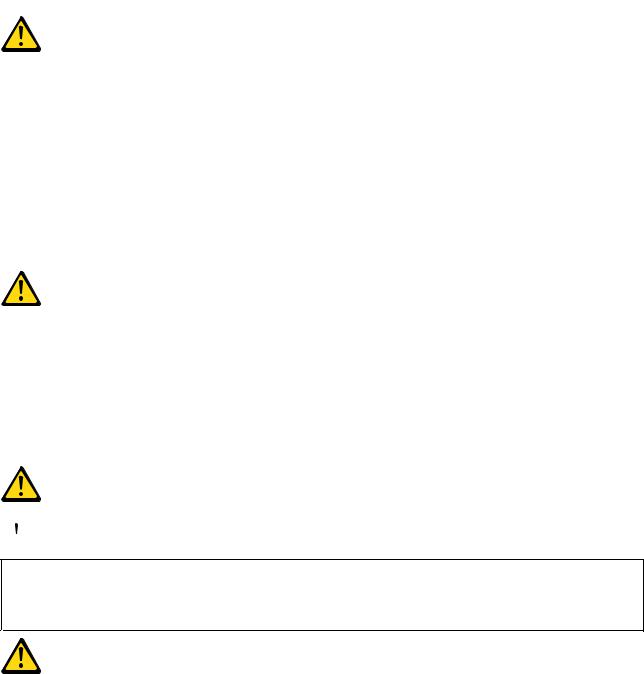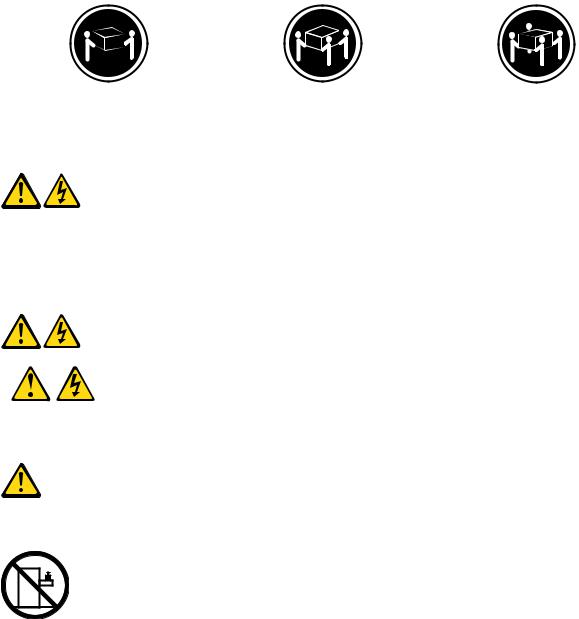Lenovo B40-30 User Manual

Lenovo B40–30 All-In-One Computer
Hardware Maintenance Manual
Machine Types: F0AW [B40-30]

Lenovo B40–30 All-In-One Computer
Hardware Maintenance Manual
Machine Types: F0AW [B40-30]
First Edition (May 2014)15
© Copyright Lenovo 2014.
LIMITED AND RESTRICTED RIGHTS NOTICE: If data or software are delivered pursuant a General Services Administration “GSA” contract, use, reproduction, or disclosure is subject to restrictions set forth in Contract No. GS-35F-05925

Contents
Chapter 1. About this manual . . . . |
. . |
1 |
Important Safety Information . . . . . . . . |
. . |
1 |
Chapter 2. Safety information . . . . |
. . |
3 |
General safety . . . . . . . . . . . . . . |
. . |
3 |
Electrical safety . . . . . . . . . . . . . |
. . |
3 |
Safety inspection guide . . . . . . . . . . |
. . |
5 |
Handling electrostatic discharge-sensitive |
|
|
devices . . . . . . . . . . . . . . . . |
. . |
5 |
Grounding requirements . . . . . . . . . . |
. . |
6 |
Safety notices . . . . . . . . . . . . . . |
. . |
6 |
Chapter 3. General information . . . |
. . |
9 |
Specifications . . . . . . . . . . . . . . |
. . |
9 |
Chapter 4. General Checkout . . . . |
. |
11 |
Chapter 5. Using the Setup Utility. . |
. |
13 |
Starting the Lenovo BIOS Setup Utility program |
. |
13 |
Viewing and changing settings . . . . . . . |
. |
13 |
Using passwords. . . . . . . . . . . . . |
. |
13 |
Enabling or disabling a device . . . . . . . |
. |
15 |
Selecting a startup device . . . . . . . . . |
. |
16 |
Exiting the Lenovo BIOS Setup Utility program . |
. |
17 |
Chapter 6. Symptom-to-FRU Index . |
. |
19 |
Hard disk drive boot error . . . . . . . . . |
. |
19 |
Power Supply Problems . . . . . . . . . . |
. |
19 |
POST error codes . . . . . . . . . . . . |
. |
20 |
Undetermined problems . . . . . . . . . . |
. |
20 |
Chapter 7. Replacing hardware . . . . |
21 |
General information. . . . . . . . . . . . . |
21 |
Replacing the keyboard and mouse . . . . . . |
22 |
Replacing the adapter . . . . . . . . . . . . |
22 |
Removing the stand base . . . . . . . . . . |
23 |
Removing the foot cover . . . . . . . . . . . |
24 |
Replacing the memory module . . . . . . . . |
25 |
Replacing the hard disk drive . . . . . . . . . |
26 |
Replacing the optical drive . . . . . . . . . . |
27 |
Removing the stand holder . . . . . . . . . . |
28 |
Removing the middle cover . . . . . . . . . |
29 |
Replacing the converter board . . . . . . . . |
31 |
Removing the EMI cover . . . . . . . . . . . |
31 |
Replacing the Wi-Fi card. . . . . . . . . . . |
32 |
Replacing the TV tuner card . . . . . . . . . |
33 |
Replacing the heat-sink . . . . . . . . . . . |
34 |
Replacing the CPU . . . . . . . . . . . . . |
35 |
Replacing the system fan . . . . . . . . . . |
37 |
Replacing the speaker system . . . . . . . . |
38 |
Replacing the power switch board . . . . . . . |
39 |
Replacing the motherboard. . . . . . . . . . |
40 |
Removing the rear deco . . . . . . . . . . . |
42 |
Replacing the camera . . . . . . . . . . . . |
43 |
Replacing the LED panel module . . . . . . . |
44 |
Chapter 8. FRU lists . . . . . . . . . . |
49 |
Chapter 9. General information . . . . 57
Additional Service Information . . . . . . . . |
57 |
© Copyright Lenovo 2014 |
iii |
iv Lenovo B40–30 All-In-One Computer Hardware Maintenance Manual

Chapter 1. About this manual
This manual contains service and reference information for Lenovo B40–30 All-In-One computers listed on the cover. It is intended only for trained servicers who are familiar with Lenovo computer products.
Before servicing a Lenovo product, be sure to read the Safety Information.
The description of the TV-tuner card in this manual applies only to computers with a TV-tuner card installed. It does not apply to computers without a TV-tuner card.
Important Safety Information
Be sure to read all CAUTION and DANGER sections in this manual before following any of the instructions.
Veuillez lire toutes les consignes de type DANGER et ATTENTION du présent document avant d’exécuter les instructions.
Lesen Sie unbedingt alle Hinweise vom Typ “ACHTUNG” oder “VORSICHT” in dieser Dokumentation, bevor Sie irgendwelche Vorgänge durchführen
Leggere le istruzioni introdotte da ATTENZIONE e PERICOLO presenti nel manuale prima di eseguire una qualsiasi delle istruzioni
Certifique-se de ler todas as instruções de cuidado e perigo neste manual antes de executar qualquer uma das instruções
Es importante que lea todas las declaraciones de precaución y de peligro de este manual antes de seguir las instrucciones.
© Copyright Lenovo 2014 |
1 |
2 Lenovo B40–30 All-In-One Computer Hardware Maintenance Manual

Chapter 2. Safety information
This chapter contains the safety information that you need to be familiar with before servicing a computer.
General safety
Follow these rules to ensure general safety:
•Keep the areas around the computer clear and clean during and after maintenance.
•When lifting any heavy object:
1.Ensure you can stand safely without slipping.
2.Distribute the weight of the object equally across both feet.
3.Lift slowly. Never move suddenly or twist when you attempt to lift.
4.Lift by standing or by pushing up with your leg muscles; this action removes the strain from the muscles in your back.
Do not attempt to lift any objects that weigh more than 16 kg (35 lb) or objects that you think are too heavy for you.
•Do not perform any action that would create a hazard for the customer, or would make the computer unsafe.
•Before you start the computer, ensure that other service representatives and customer personnel are not in a position that would create a hazard for them.
•Place removed covers and other parts in a safe place, away from all personnel, while you are servicing the computer.
•Keep your tool case away from areas that people may walk through to ensure no-one trips over it.
•Do not wear loose clothing that can be trapped in the moving parts of a machine. Ensure that your sleeves are fastened or rolled up above your elbows. If your hair is long, tie or fasten it back.
•Insert the ends of your necktie or scarf inside clothing or fasten it with a non-conductive clip, approximately 8 centimeters (3 inches) from the end.
•Do not wear jewelry, chains, metal-frame eyeglasses, or metal fasteners for your clothing. Remember: Metal objects are good electrical conductors.
•Wear safety glasses when you are: hammering, drilling soldering, cutting wire, attaching springs, using solvents, or working in any other conditions that might be hazardous to your eyes.
•After service, reinstall all safety shields, guards, labels, and ground wires. Replace any safety device that is worn or defective.
•Reattach all covers correctly before returning the computer to the customer.
Electrical safety
CAUTION:
Electrical current from power, telephone, and communication cables can be hazardous. To avoid personal injury or equipment damage, disconnect any attached power cords, telecommunication cables, network cables, and modem cables before you open the computer covers, unless instructed otherwise in the installation and configuration procedures.
© Copyright Lenovo 2014 |
3 |
Observe the following rules when working on electrical equipment.
Important: Use only approved tools and test equipment. Some hand tools have handles covered with a soft material that does not insulate you when working with live electrical currents. Many customers have rubber floor mats near their equipment that contain small conductive fibers to decrease electrostatic discharge.
•Find the room emergency power-off (EPO) switch, disconnecting switch, or electrical outlet. If an electrical accident occurs, you can then operate the switch or unplug the power cord quickly.
•Do not work alone under hazardous conditions or near equipment that has hazardous voltages.
•Disconnect all power before:
–Performing a mechanical inspection
–Working near power supplies
–Removing or installing Field Replaceable Units (FRUs)
•Before you start to work on the computer, unplug the power cord. If you cannot unplug it, ask the customer to power-off the electrical outlet that supplies power to the machine and to lock the electrical outlet in the off position.
•If you need to work on a computer that has exposed electrical circuits, observe the following precautions:
–Ensure that another person, familiar with the power-off controls, is near you. Remember: Another person must be there to switch off the power, if necessary.
–Use only one hand when working with powered-on electrical equipment; keep the other hand in your pocket or behind your back.
Remember: There must be a complete circuit to cause electrical shock. By observing the above rule, you may prevent a current from passing through your body.
–When using a tester, set the controls correctly and use the approved probe leads and accessories for that tester.
–Stand on suitable rubber mats (obtained locally, if necessary) to insulate you from grounds such as metal floor strips and machine frames.
Observe the special safety precautions when you work with very high voltages; these instructions are in the safety sections of the maintenance information. Use extreme care when measuring high voltages.
•Regularly inspect and maintain your electrical hand tools to ensure they are safe to use.
•Do not use worn or broken tools and testers.
•Never assume that power has been disconnected from a circuit. First, check that it has been powered off.
•Always look carefully for possible hazards in your work area. Examples of these hazards are wet floors, non-grounded power extension cables, conditions that may cause or allow power surges, and missing safety grounds.
•Do not touch live electrical circuits with the reflective surface of a plastic dental mirror. This surface is conductive, and touching a live circuit can cause personal injury and damage to the computer.
•Do not service the following parts with the power on when they are removed from their normal operating positions in a computer:
–Power supply units
–Pumps
–Blowers and fans
–Motor generators
and similar units. (This practice ensures correct grounding of the units.)
•If an electrical accident occurs:
– Use caution; do not become a victim yourself.
4 Lenovo B40–30 All-In-One Computer Hardware Maintenance Manual

–Switch off power.
–Send another person to get medical aid.
Safety inspection guide
The intent of this inspection guide is to assist you in identifying potential hazards posed by these products. Each computer, as it was designed and built, had required safety items installed to protect users and service personnel from injury. This guide addresses only those items. However, good judgment should be used to identify potential safety hazards due to attachment of features or options not covered by this inspection guide.
If any hazards are present, you must determine how serious the apparent hazard could be and whether you can continue without first resolving the problem.
Consider the following items and the safety hazards they present:
•Electrical hazards, especially primary power (primary voltage on the frame can cause serious or fatal electrical shock).
•Explosive hazards, such as a damaged CRT face or bulging capacitor
•Mechanical hazards, such as loose or missing hardware
The guide consists of a series of steps presented as a checklist. Begin the checks with the power off, and the power cord disconnected.
Checklist:
1.Check exterior covers for damage (loose, broken, or sharp edges).
2.Power-off the computer. Disconnect the power cord.
3.Check the power cord for:
a.A third-wire ground connector in good condition. Use a meter to measure third-wire ground continuity for 0.1 ohm or less between the external ground pin and frame ground.
b.The power cord should be the appropriate type as specified in the parts listings.
c.Insulation must not be frayed or worn.
4.Remove the cover.
5.Check for any obvious alterations. Use good judgment as to the safety of any alterations.
6.Check inside the unit for any obvious hazards, such as metal filings, contamination, water or other liquids, or signs of fire or smoke damage.
7.Check for worn, frayed, or pinched cables.
8.Check that the power-supply cover fasteners (screws or rivets) have not been removed or tampered with.
Handling electrostatic discharge-sensitive devices
Any computer part containing transistors or integrated circuits (ICs) should be considered sensitive to electrostatic discharge (ESD). ESD damage can occur when there is a difference in charge between objects. Protect against ESD damage by equalizing the charge so that the computer, the part, the work mat, and the person handling the part are all at the same charge.
Notes:
1.Use product-specific ESD procedures when they exceed the requirements noted here.
2.Make sure that the ESD protective devices you use have been certified (ISO 9000) as fully effective.
When handling ESD-sensitive parts:
Chapter 2. Safety information 5

•Keep the parts in protective packages until they are inserted into the product.
•Avoid contact with other people while handling the part.
•Wear a grounded wrist strap against your skin to eliminate static on your body.
•Prevent the part from touching your clothing. Most clothing is insulative and retains a charge even when you are wearing a wrist strap.
•Use the black side of a grounded work mat to provide a static-free work surface. The mat is especially useful when handling ESD-sensitive devices.
•Select a grounding system, such as those listed below, to provide protection that meets the specific service requirement.
Note: The use of a grounding system is desirable but not required to protect against ESD damage.
–Attach the ESD ground clip to any frame ground, ground braid, or green-wire ground.
–Use an ESD common ground or reference point when working on a double-insulated or battery-operated system. You can use coax or connector-outside shells on these systems.
–Use the round ground-prong of the AC plug on AC-operated computers.
Grounding requirements
Electrical grounding of the computer is required for operator safety and correct system function. Proper grounding of the electrical outlet can be verified by a certified electrician.
Safety notices
The CAUTION and DANGER safety notices in this section are provided in the language of English.
DANGER
Electrical current from power, telephone and communication cables is hazardous.
To avoid a shock hazard:
•Do not connect or disconnect any cables or perform installation, maintenance, or reconfiguration of this product during an electrical storm.
•Connect all power cords to a properly wired and grounded electrical outlet.
•Connect any equipment that will be attached to this product to a properly wired outlet.
•When possible, use one hand only to connect or disconnect signal cables.
•Never turn on any equipment when there is evidence of fire, water, or structural damage.
•Disconnect the attached power cords, telecommunications cables, network cables, and modem cables before you open the device covers, unless instructed otherwise in the installation and configuration procedures.
•Connect and disconnect cables as described in the following table when installing, moving, or opening covers on this product or attached devices.
6 Lenovo B40–30 All-In-One Computer Hardware Maintenance Manual

To Connect |
To Disconnect |
||
|
|
|
|
1. |
Turn everything OFF. |
1. |
Turn everything OFF. |
2. |
First, attach all cables to devices. |
2. |
First, remove power cords from outlets. |
3. |
Attach signal cables to connectors. |
3. |
Remove signal cables from connectors. |
4. |
Attach power cords to outlet. |
4. |
Remove all cables from devices. |
5. |
Turn device ON. |
|
|
|
|
|
|
CAUTION:
When replacing the lithium battery, use only Part Number 45C1566 or an equivalent type battery recommended by the manufacturer. If your system has a module containing a lithium battery, replace it only with the same module type made by the same manufacturer. The battery contains lithium and can explode if not properly used, handled, or disposed of.
Do not:
•Throw into or immerse in water
•Heat to more than 100°C (212°F)
•Repair or disassemble
Dispose of the battery as required by local ordinances or regulations.
CAUTION:
When laser products (such as CD-ROMs, DVD-ROM drives, fiber optic devices, or transmitters) are installed, note the following:
•Do not remove the covers. Removing the covers of the laser product could result in exposure to hazardous laser radiation. There are no serviceable parts inside the device.
•Use of controls or adjustments or performance of procedures other than those specified herein might result in hazardous radiation exposure.
 DANGER
DANGER
Some laser products contain an embedded Class 3A or Class 3B laser diode. Note the following:
These diodes emit radiation when open. Do not stare into the beam, do not view directly with optical instruments, and avoid direct exposure to the beam.
Chapter 2. Safety information 7

|
|
|
≥18 kg (37 lbs) |
≥32 kg (70.5 lbs) |
≥55 kg (121.2 lbs) |
|
|
|
CAUTION:
Use safe practices when lifting.
CAUTION:
The power control button on the device and the power switch on the power supply do not turn off the electrical current supplied to the device. The device also might have more than one power cord. To remove all electrical current from the device, ensure that all power cords are disconnected from the power source.
2 


 1
1 



CAUTION:
Do not place any object weighing more than 82 kg (180 lbs.) on top of rack-mounted devices.
8 Lenovo B40–30 All-In-One Computer Hardware Maintenance Manual

Chapter 3. General information
This chapter provides general information that applies to all computer models covered by this manual.
Specifications
This section lists the physical specifications for your computer.
This section lists the physical specifications for your computer.
Type Lenovo B40–30
This section lists the physical specifications.
Environment
Air temperature:
Operating: 10° to 35°C
Transit: -20° to 55°C
Humidity:
Operating: 35% to 80%
Transit: 20% to 90% (40°C)
Altitude: 86KPa to 106KPa
Electrical input:
Input voltage: 90V-264V(AC)
Input frequency: 47Hz-63Hz
© Copyright Lenovo 2014 |
9 |
10 Lenovo B40–30 All-In-One Computer Hardware Maintenance Manual

Chapter 4. General Checkout
Attention: The drives in the computer you are servicing might have been rearranged or the drive startup sequence may have been changed. Be extremely careful during write operations such as copying, saving, or formatting. Data or programs can be overwritten if you select an incorrect drive.
General error messages appear if a problem or conflict is found by an application, the operating system, or both. For an explanation of these messages, refer to the information supplied with that software package.
Use the following procedure to help determine the cause of the problem:
1.Power-off the computer and all external devices.
2.Check all cables and power cords.
3.Set all display controls to the middle position.
4.Power-on all external devices.
5.Power-on the computer.
•Look for displayed error codes.
•Look for readable instructions or a main menu on the display.
If you did not receive the correct response, proceed to step 6. If you did receive the correct response, proceed to step 7.
6.If one of the following happens, follow the instruction given:
•If the computer displays a POST error, go to “POST error codes”.
•If the computer hangs and no error is displayed, continue at step 7.
7.If the test stops and you cannot continue, replace the last device tested.
© Copyright Lenovo 2014 |
11 |
12 Lenovo B40–30 All-In-One Computer Hardware Maintenance Manual

Chapter 5. Using the Setup Utility
The Setup Utility program is used to view and change the configuration settings of your computer, regardless of which operating system you are using. However, the operating system settings might override any similar settings in the Setup Utility program.
Starting the Lenovo BIOS Setup Utility program
To start the Lenovo BIOS Setup Utility program, do the following:
1.If your computer is already on when you start this procedure, shut down the operating system and turn off the computer.
2.Press and hold the F1 key then turn on the computer. When the Lenovo BIOS Setup Utility program is displayed, release the F1 key.
Note: If a Power-On Password or an Administrator Password has been set, the Setup Utility program menu will not be displayed until you type your password. For more information, see “Using passwords.”
Viewing and changing settings
System configuration options are listed in the Lenovo BIOS Setup Utility program menu. To view or change settings, see “Starting the Setup Utility program.”
You must use the keyboard when using the Lenovo BIOS Setup Utility menu. The keys used to perform various tasks are displayed on the bottom of each screen.
Using passwords
You can use the Lenovo BIOS Setup Utility program to set passwords to prevent unauthorized persons from gaining access to your computer and data. See “Starting the Setup Utility program.” The following types of passwords are available:
•Administrator Password
•Power-On Password
You do not have to set any passwords to use your computer. However, if you decide to set passwords, read the following sections.
Password considerations
A password can be any combination of letters and numbers up to 16 characters (a-z and 0-9). For security reasons, it is a good idea to use a strong password that cannot be easily compromised. We suggest that passwords should follow these rules:
•For a strong password, use 7-16 characters and a mix of letters and numbers.
•Do not use your name or your user name.
•Do not use a common word or a common name.
•Use something significantly different from your previous password.
Attention: Administrator and Power-On passwords are not case sensitive.
© Copyright Lenovo 2014 |
13 |
